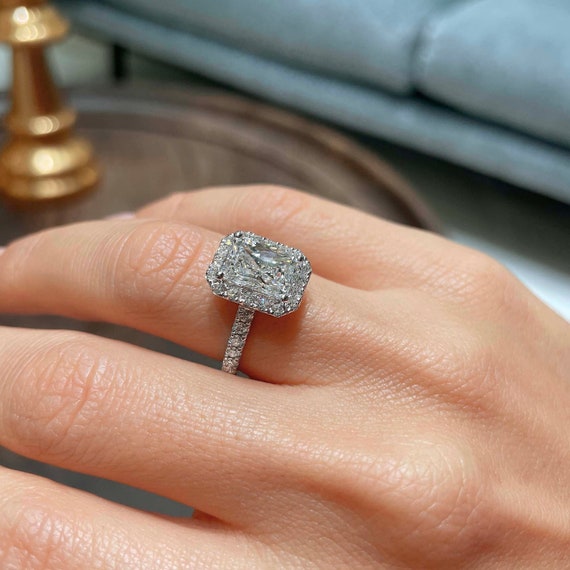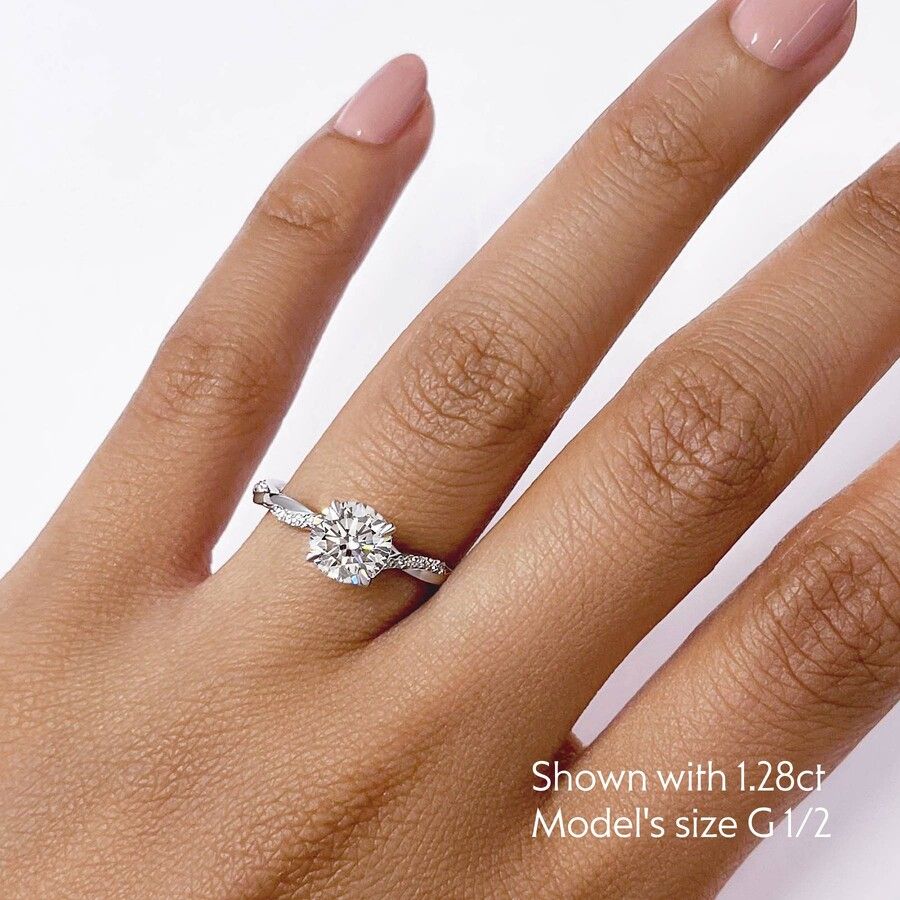Comprehending the Advantages of Laboratory Grown Diamond Interaction Rings in Today's Market
Lab-grown Diamond involvement rings are becoming significantly popular in today's market. These alternatives to extracted diamonds provide a variety of benefits that attract contemporary consumers. From environmental sustainability to set you back financial savings, lab-grown rubies provide an engaging choice. Their boosted quality and modification alternatives even more add to their allure. The growing rate of interest raises questions regarding the effects of these selections. What elements should couples consider when selecting lab-grown over conventional diamonds?
The Ecological Benefits of Lab-Grown Diamonds
As customers progressively focus on sustainability, lab-grown rubies emerge as an engaging option to their extracted counterparts. These artificial treasures are generated in regulated environments, significantly lowering the ecological footprint related to typical Diamond mining. The removal of all-natural diamonds commonly causes environment damage, dirt disintegration, and water air pollution, ravaging regional communities. On the other hand, lab-grown diamonds need less land and water, reducing resource depletion.
Furthermore, the energy used in the creation of lab-grown diamonds can be sourced from sustainable power, additional decreasing their environmental impact. This process not only curbs carbon emissions yet additionally promotes sustainable practices within the precious jewelry sector. Consumers that go with lab-grown rubies add to an extra honest and environmentally pleasant market, aligning their buying options with their worths. On the whole, lab-grown rubies present a service that harmonizes luxury with ecological obligation, interesting an expanding group worried about sustainability.
Cost-Effectiveness of Lab-Grown Involvement Rings
While several pairs look for to stabilize high quality and spending plan when choosing involvement rings, lab-grown diamonds offer an affordable choice without compromising on beauty or toughness. Typically valued 20-40% less than their natural equivalents, lab-grown diamonds allow couples to designate their spending plan a lot more flexibly, allowing bigger carat sizes or higher high quality rocks for the exact same cost. This price does not interfere with the visual charm; lab-grown rubies show the very same sparkle and quality as mined diamonds, many thanks to the same chemical and physical properties. In addition, the market for lab-grown diamonds is broadening, resulting in affordable pricing and increased availability. Couples can also take pleasure in a broader series of styles and setups without the financial stress usually connected with traditional rubies. Overall, lab-grown interaction rings provide an attractive monetary option, making them progressively prominent amongst contemporary pairs who prioritize both expense and high quality in their getting choices.
Ethical Considerations in Selecting Lab-Grown Diamonds

Consumers are progressively concerned about the beginnings of their acquisitions, and lab-grown diamonds provide a clear supply chain. Each Diamond comes with certification outlining its creation process, making sure purchasers can make enlightened choices. In addition, the manufacturing of these rubies typically utilizes renewable resource resources, further lining up with eco-conscious values. For people prioritizing ethical intake, lab-grown rubies present a responsible option that merges high-end with moral stability, interesting modern-day sensibilities in interaction ring choices.

High quality and Beauty: Comparing Lab-Grown and Mined Diamonds
The comparison in between lab-grown and extracted diamonds exposes remarkable differences in visual features and longevity. Lab-grown rubies commonly display exceptional quality and shade uniformity, while mined rubies can provide unique incorporations and variations. In addition, both types share the exact same firmness, making them just as suitable for interaction rings.
Aesthetic Characteristics Contrast
Exactly how do lab-grown diamonds compare to their mined equivalents regarding visual qualities? Both kinds of diamonds share identical physical and chemical residential or commercial properties, making it testing to compare them without specialized tools. Lab-grown diamonds usually show less imperfections and additions, leading to superior quality. Furthermore, they can be generated in a broader variety of shades, permitting for unique personalization options. While extracted diamonds are prized for their natural origin and viewed rarity, lab-grown diamonds can attain equal beauty and radiance, frequently at a reduced expense. Inevitably, the option between the two might come down to individual choice, yet visually, lab-grown rubies stand as a compelling option, boasting high quality that equals their natural equivalents.
Sturdiness and Solidity Elements
While both lab-grown and extracted diamonds have remarkable toughness, their hardness continues to be a defining particular that emphasizes their viability for day-to-day wear. Rubies are ranked a 10 on the Mohs range of mineral firmness, making them the hardest all-natural product known (lab grown diamond engagement rings). This particular guarantees that both kinds of diamonds withstand scratching and keep their brilliance gradually. Lab-grown diamonds, produced under regulated problems, display the very same firmness and physical properties as their extracted equivalents. As an outcome, they offer a resistant and attractive choice for interaction rings. Consumers can with confidence choose either type, recognizing that both provide enduring top quality. Ultimately, the option between lab-grown and extracted diamonds may come down to individual worths as opposed to distinctions in toughness or hardness
Modification Options for Lab-Grown Diamonds
Lab-grown diamonds supply a large variety of personalization choices that cater to specific preferences. From one-of-a-kind style possibilities to various shade and cut selections, these diamonds can be tailored to match any type of individual design. This level of personalization assurances that each interaction ring can mirror the distinctive preferences of the wearer.
Unique Design Opportunities
Countless design opportunities await those interested in lab-grown Diamond interaction rings, permitting couples to share their special romance. With the flexibility of lab-grown rubies, designers can discover a wide variety of designs, from classic jewelry to complex vintage settings. Pairs can choose from various shapes, such as round, princess, or emerald cuts, each providing an unique character. Additionally, the capability to choose one-of-a-kind metal kinds, including white gold, rose gold, or platinum, more improves modification. Lab-grown rubies can additionally be morally sourced in different carat weight weights, making it possible for couples to find the excellent equilibrium in between size and budget plan. This flexibility allows each ring to mirror the private tastes and choices of the pair, making it a really personal sign of their commitment.
Personalization for Every Design
The flexibility of lab-grown diamonds extends beyond unique style possibilities, providing comprehensive modification options to fit every couple's design. Pairs can select from different settings, metals, and read what he said band designs, ensuring that their interaction ring reflects their individuality. Choices range from classic solitaires to contemporary halo styles, enabling for individual expression in every option. In addition, couples can choose particular attributes such as inscription, including nostalgic value and uniqueness to their rings. The capability to personalize assurances that each ring is her explanation not just a representation of love yet also a representation of personal taste and lifestyle. This degree of personalization makes lab-grown rubies an appealing selection for those seeking a meaningful and unique involvement ring.
Shade and Cut Options
Involvement rings including lab-grown rubies supply a stunning variety of shade and cut options that enhance their appeal and individuality. Unlike typical rubies, lab-grown choices can be created in a considerable array of colors, consisting of pink, blue, and yellow, allowing pairs to choose a distinctly individual touch. These vivid colors can act as a significant representation of love and dedication.
Lab-grown rubies come in numerous cuts, including round, oval, and princess, each adding to the stone's luster and aesthetic appeal. This versatility enables pairs to tailor their rings to reflect their styles and choices. Ultimately, the availability of varied color and cut options makes lab-grown Diamond interaction rings a preferred option for modern pairs looking for customization.
Trends and Popularity of Lab-Grown Diamonds in 2023
As consumers increasingly prioritize sustainability and moral considerations in their buying choices, the popularity of lab-grown rubies has surged in 2023. This year, the marketplace has actually witnessed a notable change, with more pairs choosing these diamonds as a result of their lower ecological impact and transparent sourcing procedures. Lab-grown rubies are not just significantly a lot more budget-friendly than their mined counterparts, but they also offer a variety of styles and modification alternatives that interest contemporary consumers.
Merchants have actually reacted to this expanding fad by expanding their collections and emphasizing the distinct qualities of lab-grown stones, such as their brilliance and clearness. Social media site and influencer recommendations have actually even more magnified understanding, making lab-grown diamonds a trendy option for engagement rings. As education and learning about the benefits proceeds to spread, it is expected that the market share of lab-grown rubies will remain to increase, solidifying their location in the fashion jewelry sector.
Frequently Asked Inquiries
Just How Are Lab-Grown Diamonds Developed in a Laboratory?
Lab-grown diamonds are created using 2 key methods: High Stress Heat (HPHT) mimics natural Diamond development problems, while Chemical Vapor Deposition (CVD) makes use of gas to precipitate carbon onto a substrate, developing rubies layer by layer.
Do Lab-Grown Diamonds Hold Their Value Over Time?
Lab-grown diamonds typically do not hold their value as well as natural diamonds. Market fluctuations and consumer understandings influence resale rates, resulting in reduced long-term worth retention for lab-grown alternatives contrasted to their natural counterparts.
Can Lab-Grown Diamonds Be Resized Like Mined Diamonds?
Lab-grown diamonds can be resized in a similar way to mined diamonds, as they have comparable physical buildings. Jewelers typically use basic strategies for resizing, making sure that both sorts of rubies preserve their honesty and aesthetic charm during the procedure.
Are Lab-Grown Diamonds Available in Numerous Sizes And Shapes?
Lab-grown rubies are without a doubt readily available in a selection of sizes and shapes. They can be customized to satisfy specific choices, providing options like round, princess, oval, and emerald cuts, among others, ensuring varied choices for consumers.
Just how Do I Confirm the Authenticity of a Lab-Grown Diamond?
To confirm the credibility of a lab-grown Diamond, one should consult a reputable jeweler or obtain a certification from an acknowledged grading laboratory, which normally includes information concerning the Diamond's origin and qualities.
Lab-grown diamonds are developed in regulated environments, removing the environmental destruction commonly associated with typical Diamond have a peek at this site mining. lab grown diamond engagement rings. Lab-grown diamonds typically show superior clearness and shade uniformity, while mined rubies can present special incorporations and variants. While extracted rubies are valued for their all-natural beginning and viewed rarity, lab-grown diamonds can achieve equivalent charm and sparkle, often at a lower expense. Lab-grown diamonds generally do not hold their value as well as natural rubies. Lab-grown diamonds can be resized likewise to extracted diamonds, as they possess equivalent physical buildings